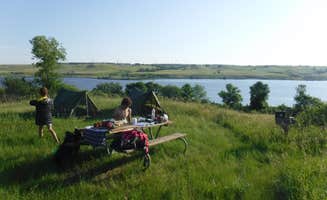Primitive tent campsites near Fort Ransom, North Dakota offer rustic camping experiences in the eastern region of the state. Located in the Sheyenne River Valley, this rural area sits approximately 1,100 feet above sea level with terrain characterized by river valleys and rolling hills. Summer temperatures typically range from 65-85°F while spring and fall bring cooler conditions with higher precipitation potential.
What to do
Lake exploration: Backcountry Campsite provides direct access to Lake Ashtabula for paddling and fishing. The site connects to hiking trails along the North Country Trail system with walk-in tent sites accessible via established paths.
Wildlife observation: The area surrounding Valley City National Fish Hatchery offers opportunities to spot local wildlife and waterfowl. One visitor noted, "It would be fun to start at the dam in a canoe and use this as a place to stop for the night," suggesting potential multi-day paddling routes.
Seasonal activities: During spring and fall, hiking trails near primitive camping areas showcase seasonal changes. Summer visitors can take advantage of longer daylight hours for extended hikes and water activities, while early fall brings cooler temperatures ideal for tent camping.
What campers like
Solitude and quiet: Primitive camping areas around Fort Ransom attract those seeking isolation from developed campgrounds. The backcountry sites require additional effort to reach but reward campers with peaceful natural settings away from crowds.
Basic amenities: Some sites offer surprising comforts despite their remote locations. As one Backcountry Campsite visitor reported, "The primitive toilet even had a mailbox with toilet paper!" This indicates thoughtful maintenance of even basic facilities at some locations.
Water access: The connection between camping and water recreation ranks high among visitor preferences. Sites near Lake Ashtabula provide direct water access for fishing, paddling, and wildlife viewing while maintaining primitive camping conditions.
What you should know
Limited services: Most tent camping sites near Fort Ransom lack amenities like drinking water, trash service, or electrical hookups. Campers must be self-sufficient and prepared to pack out all waste.
Seasonal availability: Camping seasons typically run April through October, with Wyndemere Rock Garden County Park specifically noting this operational period. However, recent visitor reports indicate possible closures: "I don't think this is open... I wouldn't stay in either place."
Access challenges: Some sites have restricted access or unclear status. At Valley City National Fish Hatchery, a visitor reported, "There is a small campground but I'm guessing it is for a girl scout group or something like that. It didn't seem very well used and was locked tight. There are signs stating no entry after dark."
Tips for camping with families
Preparation essentials: When bringing children to primitive tent campsites near Fort Ransom, pack extra water, food supplies, and weather-appropriate clothing. Temperature fluctuations can be significant between day and night, especially in spring and fall seasons.
Activity planning: Plan shorter hikes and bring activities that don't require electricity or additional facilities. The Backcountry Campsite location has been family-tested, with one visitor sharing, "My kids and I enjoyed this site on our hike along the NCT on Lake Ashtabula."
Safety considerations: Cell service can be limited in remote camping areas. Bring a first aid kit, emergency contact information, and inform someone of your planned location and expected return time when venturing to primitive sites with children.
Tips from RVers
Size limitations: Most primitive camping areas near Fort Ransom cannot accommodate RVs or larger vehicles. Tent camping is the primary option with no hookups or services available at these remote sites.
Alternative options: RV campers should consider established campgrounds with appropriate facilities rather than the primitive tent sites described. Primitive sites near Fort Ransom generally have walk-in, hike-in, or boat-in access that prevents RV use.


